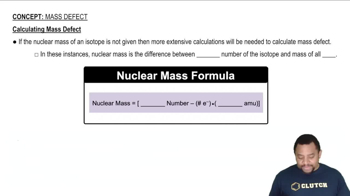Here are the essential concepts you must grasp in order to answer the question correctly.
Binding Energy
Binding energy is the energy required to disassemble a nucleus into its constituent protons and neutrons. It reflects the stability of a nucleus; a higher binding energy indicates a more stable nucleus. This energy can be calculated using the mass defect, which is the difference between the mass of the individual nucleons and the mass of the nucleus itself.
Recommended video:
Mass Defect
The mass defect is the difference between the total mass of the separate nucleons and the actual mass of the nucleus. This discrepancy arises because some mass is converted into energy when nucleons bind together, according to Einstein's equation E=mc². The mass defect is crucial for calculating the binding energy of a nucleus.
Recommended video:
MeV/nucleon
MeV/nucleon is a unit of measurement that expresses binding energy per nucleon in mega-electronvolts. This unit allows for easy comparison of the binding energies of different nuclei, as it normalizes the energy value to the number of nucleons present. Understanding this unit is essential for interpreting the stability and energy characteristics of various isotopes.
Recommended video:
 Verified step by step guidance
Verified step by step guidance


